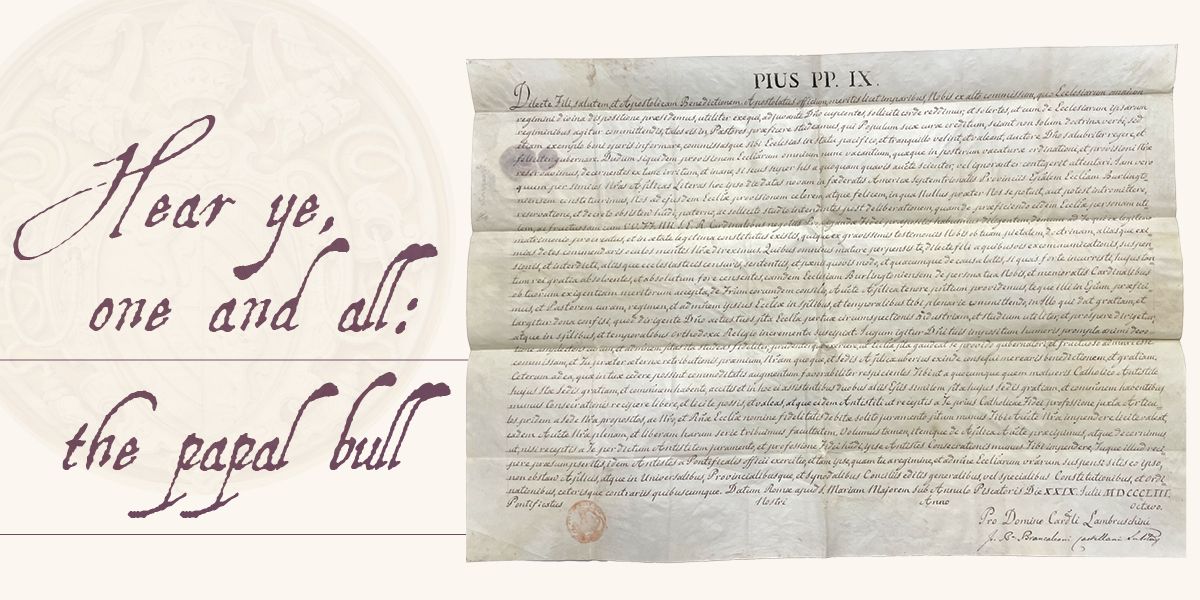
Hear ye, one and all: the papal bull
A series of papal bulls were issued 170 years ago, following the First Plenary Council of Baltimore in 1853. These were issued to appoint bishops to specific Dioceses or to grant certain privileges or responsibilities to particular episcopal sees, addressing matters related to the governance and administration of Dioceses.
Among the persons to receive bulls of this nature was, at the time, Vicar General of the Diocese of Cleveland Louis deGoësbriand. Pope Pius IX formally erected a new Diocese assigned for the whole state of Vermont, with its episcopal see in the City of Burlington and naming Father deGoësbriand as its bishop on July 29, 1853.
A papal bull is a type of official document issued by the pope. It is written in Latin and typically sealed with a round, lead medallion called a bulla. The bulla bears a pontifical seal and is attached to the document itself by a corded ribbon. Papal bulls, also known as papal briefs, have been used by the Catholic Church since medieval times to communicate various decisions, proclamations, and decrees.
The purpose of issuing papal bulls to bishops and Dioceses is to convey authoritative instructions, decisions, or teachings from the pope to specific regions or individuals within the Church. These documents are significantly influential and considered binding on the recipients. Papal bulls can serve several purposes, including:
- Doctrinal or dogmatic declarations: Bulls have been used to define and clarify matters of faith, doctrine, or theological disputes within the Church. The papal bull Ineffabilis Deus, for example, was issued by Pope Pius IX on Dec. 8, 1854. This bull defined the dogma of the Immaculate Conception, which asserts that the Blessed Virgin Mary was conceived without the stain of original sin. It was issued in response to a request from the Catholic faithful and the bishops, who sought a formal declaration of this belief.
- Beatifications and canonizations: The pope may issue a bull to officially recognize the sainthood of an individual or declare them blessed, affirming the sanctity and intercessory power of the person being beatified or canonized.
- Indulgences and spiritual benefits: Bulls historically have been used to grant indulgences, which are remissions of temporal punishment for sins. These documents would specify the conditions under which the indulgences could be obtained and their spiritual benefits.
- Jurisdictional matters: Papal bulls can establish or modify the boundaries of ecclesiastical territories, create new Dioceses, or make changes to existing ones. They also address matters related to the hierarchy and organization of the Church.
A papal bull typically consists of several components, each serving a specific purpose. These are the main components typically found in a papal bull:
- Preamble: The bull begins with a preamble that provides essential information, including the pope’s name, the title of the bull, and the reasons for its issuance.
- Introduction: This addresses the purpose of the document. It may outline the historical context or specific circumstances that led to its issuance.
- Body: The body of the bull contains the main content. It includes the instructions, decisions, teachings, or declarations being communicated by the pope.
- Considerations: This section presents the reasoning behind the pope’s decisions or teachings. It may draw on scripture, tradition, theological principles, or historical precedents to support the statements made in the bull.
- Conclusions: The conclusions section summarizes the main points of the bull and restates the instructions or decisions being conveyed. It often includes an exhortation to the recipients to abide by the contents of the document.
- Signatures and Seal: Papal bulls bear the signatures of the pope and high-ranking officials in the Vatican hierarchy who were involved in the preparation and issuance of the document. The bull is then sealed with a bulla; the seal authenticates the document and represents the authority of the pope.
- Date and place: The bull concludes with the date and place of its issuance, typically in the form of the year of the pope’s pontificate and the location. We note the bulls regarding the Diocese of Burlington, issued by Pope Pius IX, were “Given at Rome, at Saint Mary Major, under the Ring of the Fisherman, in the 29 th day of July in the year MDCCCLIII (1853), the eighth of Our Pontificate for the Lord Cardinal Lambrushini, J. B. Brancaleoni – Castellani, Secretary.”
It is important to note that the structure and components of a papal bull may vary to some extent depending on historical periods, individual preferences of the pope, and the specific nature of the document being issued. Of additional note, the use of papal bulls has evolved over time. Their frequency and nature may vary depending on the needs and practices of different pontificates. In contemporary times, the Church may use other means of communication and documentation to convey similar messages, but the historical significance and authority of papal bulls remain.
Sources:
Britannica, T. Editors of Encyclopaedia (2023, March 30). papal bull. Encyclopedia Britannica. britannica.com/topic/bull-papal
Gallus, T. (1949). Patres Ecclesiaeque Scriptores in Bulla Pii IX Ineffabilis Deus. Divus Thomas, 52, 77–82. jstor.org/stable/45082115
—Kathleen Messier is the assistant archivist for the Diocese of Burlington. For more information, email Archives@vermontcatholic.org.
—Originally published in the Summer 2023 issue of Vermont Catholic magazine.

